Electric Car Reviews | Benefits of Electric Cars For Families
Wondering if it’s time to get an electric car for your family? Curious about the costs and benefits of an electric car? We did a mind-numbing amount of research and test drove many electric cars to find out which electric car made the most sense for our family. Read on to learn more about what we considered when purchasing an electric car for our suburban family of four.
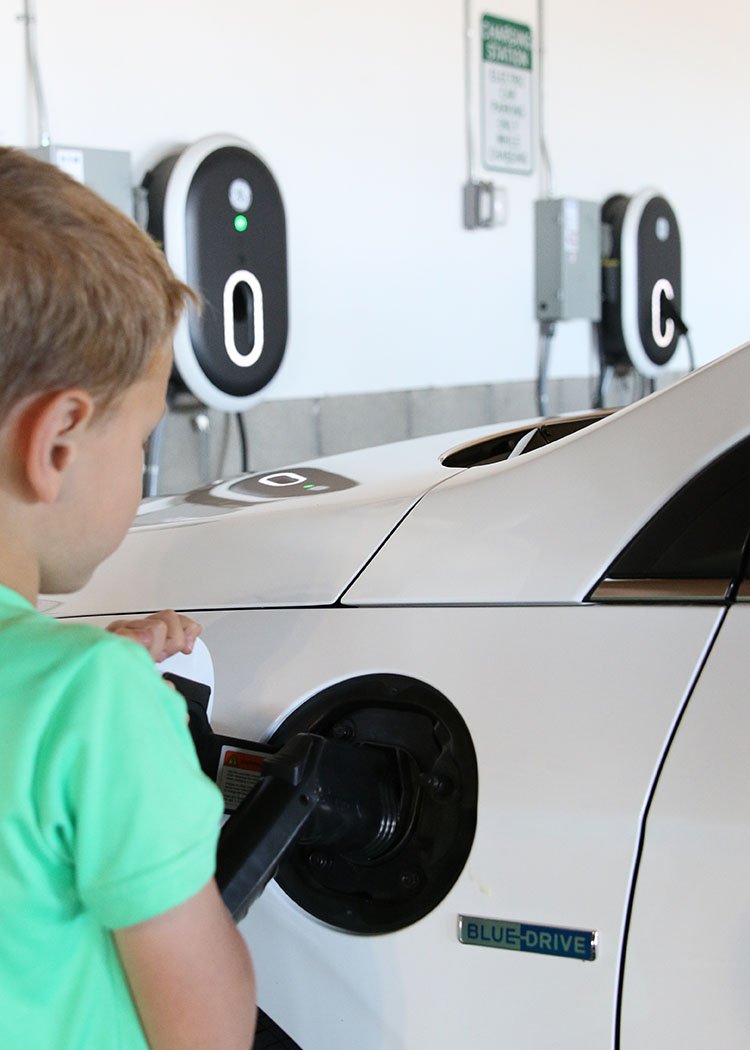
Several years ago, we rented an electric car while on vacation in San Francisco, California. I purposefully wanted a chance to check out how it felt to drive one for a few days.
A couple of years ago, a half dozen months after our electric vehicle rental, we looked into leasing an electric car. After some stops and starts, we decided not to get an electric car for our family. Many of the options were way out of our price range. Many brands entered the market with luxury electric cars before adding more affordable electric cars to their lineups.
Many traditional car dealerships either didn’t have much to offer or weren’t really on board yet with the inevitable transition to electric cars. These were just a couple of the factors that led us to lease another traditional sedan despite wanting to reduce our carbon footprint living in the suburbs.
Time To Get An Electric Vehicle For Our Family
One of our cars comes off lease in April 2022. Since our initial attempt at going electric, the market for electric vehicles has expanded significantly. Today, most major car brands have at least one electric option in their fleet. It was time to go back to the drawing board and figure out what car we wanted to lease for the next three years.
Related Reading: 6 Reasons We Chose Not To Lease An Electric Car (and why we changed our minds two years later)
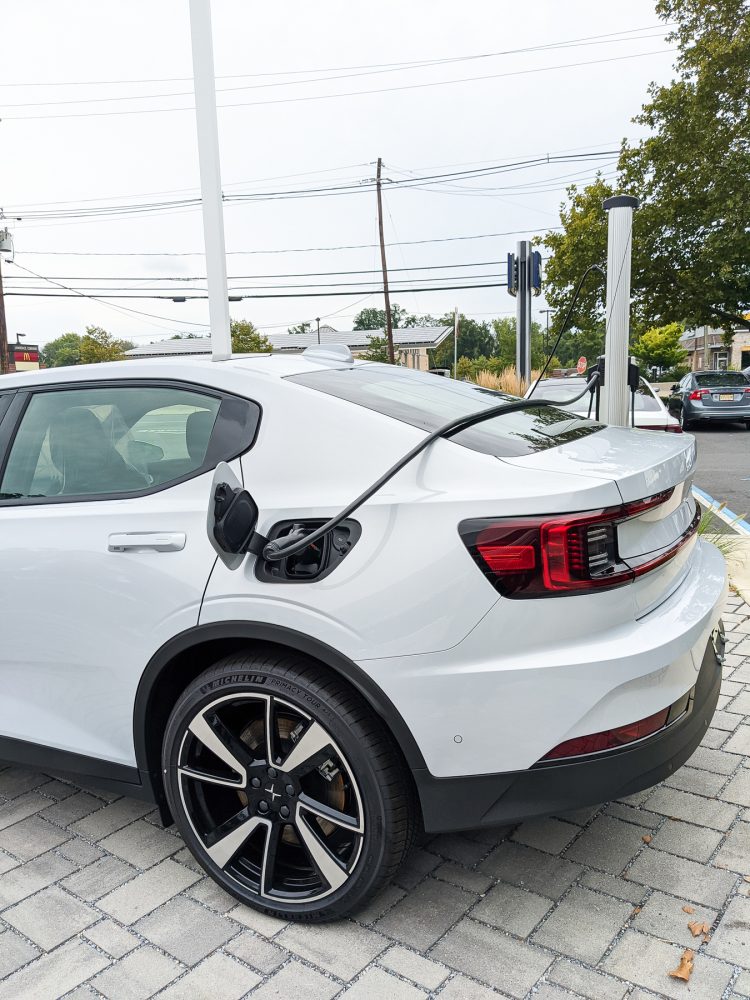
6 Great Benefits of An Electric Car
Why go electric? Some of the benefits of an electric car are pretty clear (hello cleaner air and lower gasoline bills). But there are some other less obvious benefits I learned about while doing our research for this purchase.
1. No Gasoline Purchases (+ Gas vs. Electricity Cost Savings)
This is pretty straightforward. With an EV, you no longer need to stop at a gas station to fill up. You can charge at home while you sleep, most likely saving you money and most certainly saving time.
And for those like me who are babies about getting out of the car when it’s cold outside, no more standing in the cold at a gas pump to fill up your tank. (Or for my friends in New Jersey who don’t pump their own gas, no more waiting in lines for someone else to pump your gas.)
Calculate Your Gasoline vs. Eletricity Cost Savings
Several sites offer calculators to determine how much money you can save by charging an electric car instead of purchasing gas. Savings will vary greatly depending on where you live based on the gasoline and electricity costs in your local area.
My local utility offers a calculator that incorporates an average local fuel price as well as a local utility rate to more specifically show our potential savings of an electric vehicle compared to our current car. This calculator allows you to select different types of cars, average miles driven each day, fuel prices per gallon, and more.
I didn’t modify all the options, but you could if you had more specific data. Even if your utility company doesn’t offer a calculator, you could use the options in this calculator from my utility to modify the inputs and calculate your own local savings estimate.
As shown in the video below of the EV savings calculator, we could save $75/month (or $904/yr) by charging a Tesla Model 3 instead of purchasing gasoline for our Honda Accord. Your utility may have something similar that considers local gasoline and power prices in your area.
Utility companies have an incentive to expedite the transition from fossil fuel-powered to electric cars as this shifts more energy consumption on the grid and into their energy pool. It makes sense for these companies to show consumers the potential savings they may accrue by a transition to an electric vehicle.
As I describe below, however, this shift is good for consumers and the utility alike. And when it saves the consumer money and is good for the environment, that’s a win-win.
2. Less Car Maintenance
Electric cars don’t need oil changes and require far fewer maintenance visits. While I can’t say with certainty, I got the impression when we first tried to lease an electric car that the lack of required maintenance on electric cars caused some car dealers to be reluctant to promote electric vehicles to their customers. They wanted to retain the service revenue. It was certainly an obstacle for us.
By now, however, the EV transition has surged forward, and I think these dealers realize they will be left in the dust of EVs if they don’t embrace them.
Furthermore, most electric cars (I assume all, but can’t say for sure) have regenerative braking. Regenerative braking takes the wasted energy from the process of slowing down a car and uses it to recharge the car’s batteries. Regenerative braking, in electric cars specifically, significantly reduces the wear and tear on brake systems while driving, so many electric cars need less frequent brake replacement.
Many non-electric cars also incorporate regenerative braking technology. Apparently, however, it’s not as efficient as that in electric cars, so the brake protection is less relevant.
Save money and time you would otherwise spend caring for your internal combustion engine car by choosing an electric vehicle. Some companies, like Tesla, even come to your house to service cars if and when they need service. That feels a lot better than sitting in an autobody shop or service center waiting room.
3. Special Parking Spots & Driving Lanes
In some places, electric vehicles have access to special parking spots that are closer to the door or special driving lanes that might get you somewhere more quickly. These benefits depend on where you live, but they can be a nice bonus.
4. Quieter Driving Experience
Without loud engines, electric cars are much quieter than traditional cars. It’s worth noting, however, that some are significantly quieter while others are only slightly quieter, especially while driving. All of the cars are very quiet when you turn them on. Once on the road, some are still surprisingly quiet while others sound more like traditional cars.
5. Reduced Carbon Emissions
EVs have zero direct carbon emissions, which is great for the air quality of your local community and good for the planet overall. The electricity generation used to manufacture and power the car, however, may come from a fossil-fuel-powered plant.
Thus, I think it’s misleading to suggest that driving an EV is always a zero-emission activity. It’s fair to criticize that an EV is only as good for the environment as the source of the energy used to make it and charge it.
Progress Over Perfection For Major Carbon Emission Industries
Nonetheless, the transportation and electricity sectors are the two largest sources of carbon emissions in the United States according to the U.S. Environmental Protection Agency. In other words, transitioning our electricity grid to zero-carbon energy sources while also moving our transportation industry away from fossil-fueled vehicles offers a significant opportunity to reduce carbon emissions.
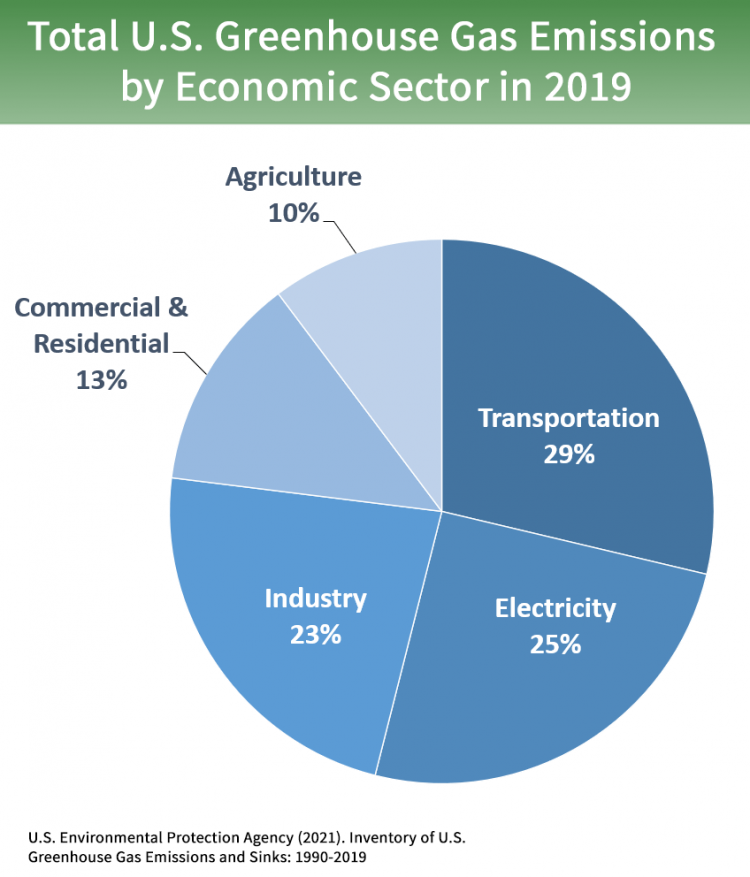
Hopefully, we transition our electric grid to include more renewable and zero-emission energy sources over time. As this happens, EVs and other electric-powered machines and devices will capitalize on this overall grid upgrade, reducing the carbon emissions from both the transportation and electricity sectors.
Calculate Your Carbon Emissions Reduction By Driving an Electric Vehicle
For now, you can use this carbon-emission calculator (for those living in the United States) to determine how the carbon emissions from charging an EV in your area compare to driving a conventional car.
I calculated the carbon emissions from our current car compared to the new electric vehicle we will get in a few months. Based on where we live and driving the EV that we chose, we will produce about 25% of the carbon emissions by charging an electric car as opposed to driving our current conventional car.
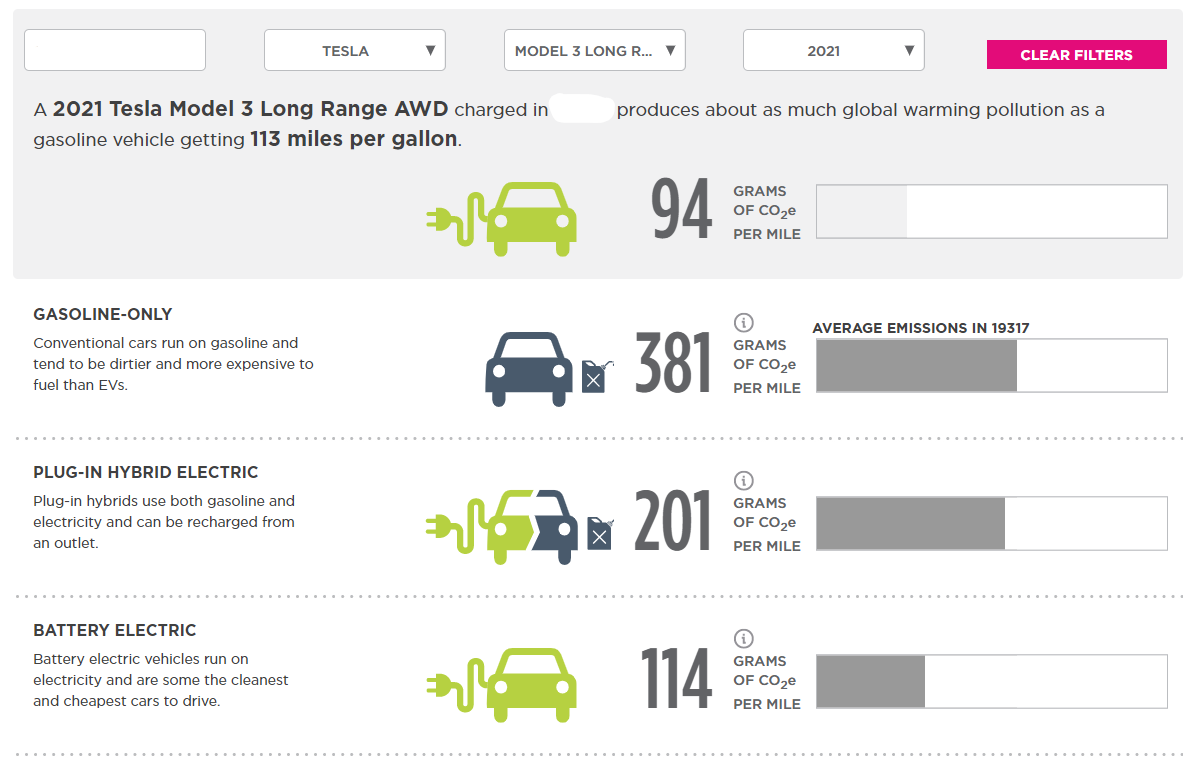
6. Allocation of Power Usage & Energy Production Costs
As noted in an article from the NRDC, electric vehicles can also reduce the electric bills for everyone. “Electric vehicle charging is good for utility customers, even if they don’t drive an EV, because added utility revenue puts downward pressure on rates,” says Luke Tonachel, director of NRDC’s Clean Vehicles and Fuels Group.
Utilities have a lot of fixed costs, and they spread those costs among all of their customers. When they have more energy usage over which to spread those costs, ratepayers pay less per unit of energy consumed (all else being equal). Additionally, electricity usage peaks during the day, and peak usage electricity is more expensive to provide than if we used energy at a steady rate throughout the day.
Many EV owners will likely charge their cars overnight, which could offer some benefit to flattening the peaks and valleys of energy usage when occurring on a large scale. As you might imagine, it’s generally more cost-efficient to run a certain number of power plants throughout the day than slowing down production at night and ramping up production during the day at plants that only function during peak energy usage periods.
I suspect that over the long term, we will see more decentralization of power production (like solar panels on roofs and even on cars themselves). But we will rely, at least to some extent, on centralized power production facilities for the foreseeable future. Transitioning more energy usage from daytime to nighttime is pretty good for everyone, even if you don’t own an electric vehicle.
Back to gasoline vs. electricity savings calculator.
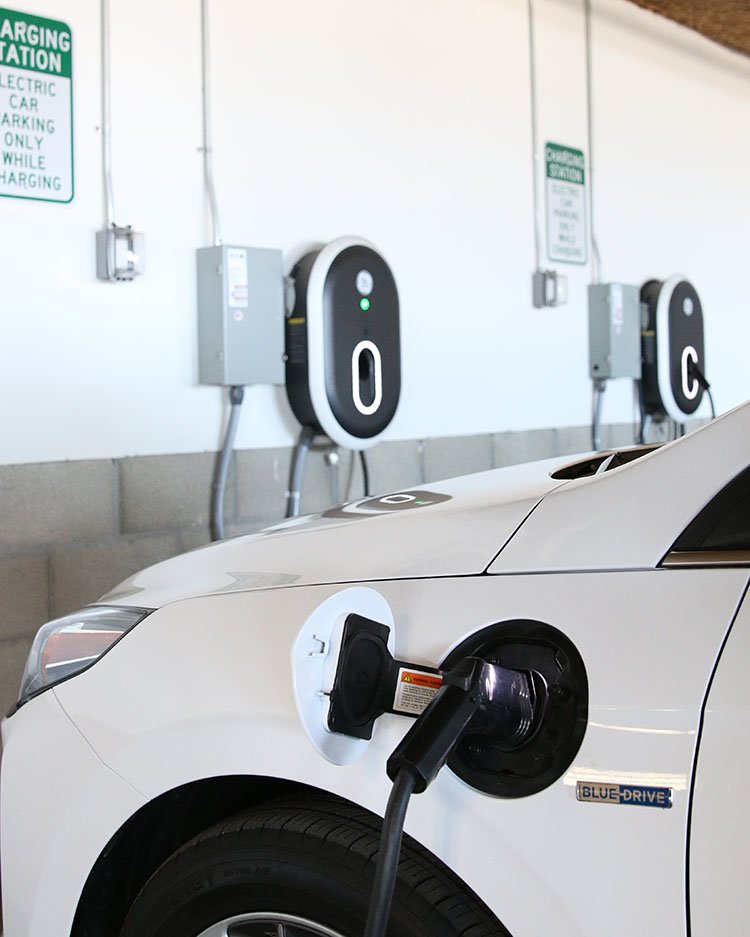
Choosing An Electric Vehicle Before We Needed It
Chip shortages and manufacturing delays drive hefty lead times right now for getting many electric cars. To have a full set of options from which to choose, we were beholden to the longest lead time of all the cars we researched (which was 9 months, if you’re curious). Thus, here we are six months before our current lease is up, and we’ve already decided what car we will get next.
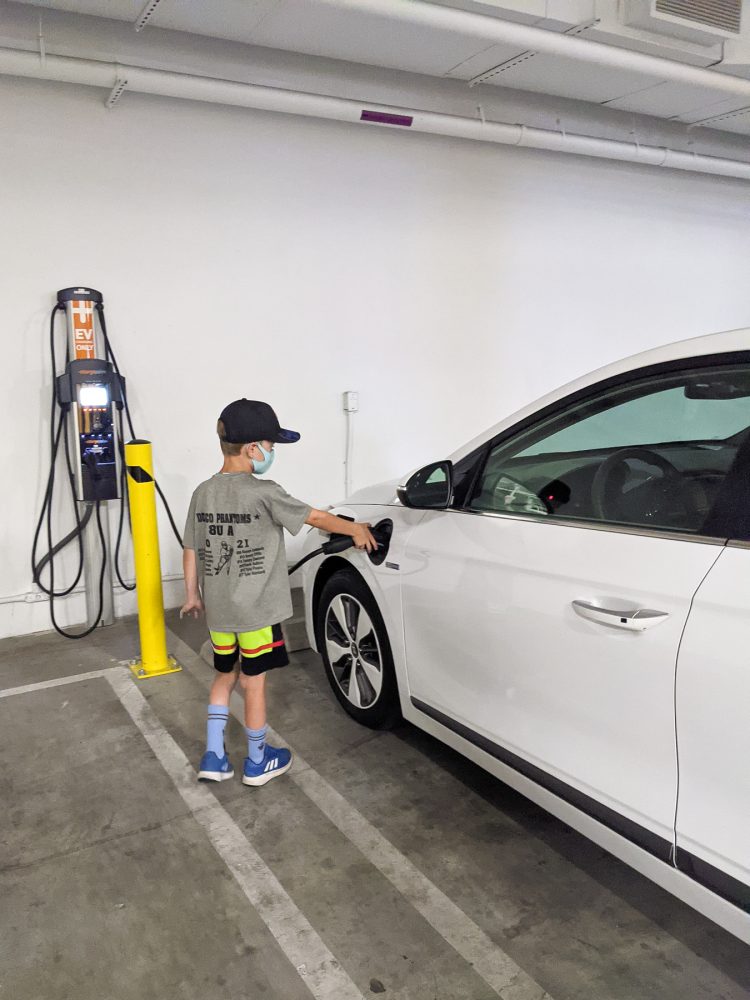
Automotive Brands That Sell Electric Cars
While the market was small a couple of years ago, the electric vehicle market is growing every day. I see new brands popping up all the time. This list is not exhaustive, but here is a list of several electric cars to consider.
Electric Cars We Test Drove
We test drove each of the electric cars listed below. I’ve shared a bunch more information about each of them based on our experience and research later in the post.
- Tesla: Model 3 and Model Y (though all of their cars are electric, and they offer higher-end Model X and Model S cars as well)
- Ford: Mustang Mach-E
- Kia: Niro EV
- Polestar: Polestar 2
- Volkswagen: ID.4
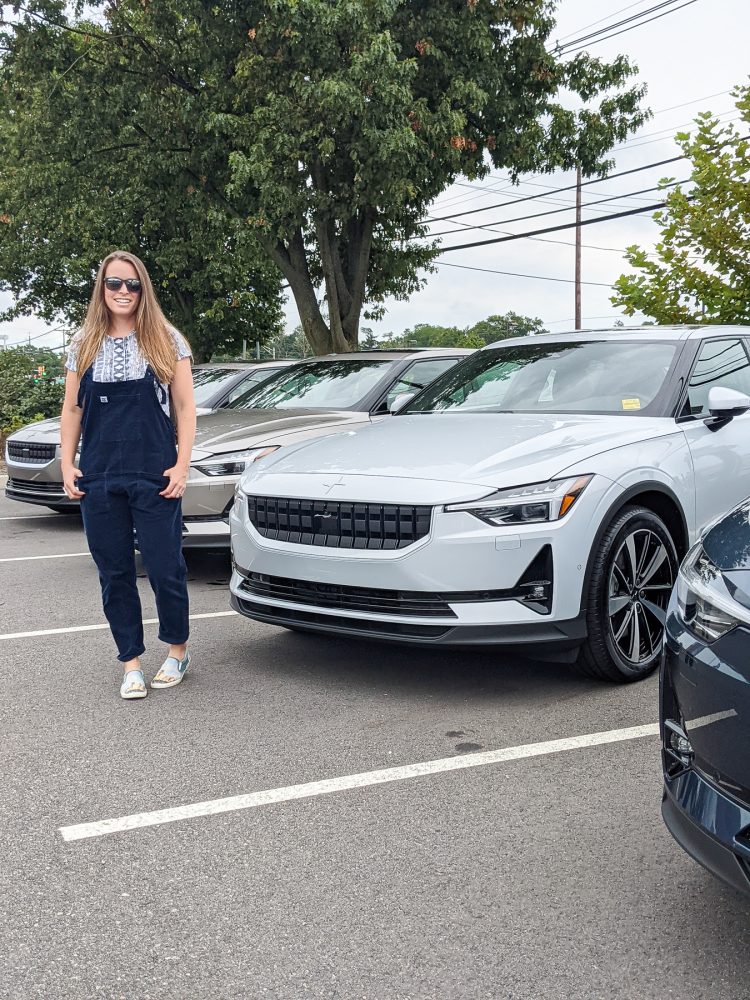
Electric Cars We Researched & Considered
After driving five different cars, I hit test driving fatigue. Clearly, I’m not cut out to be a car reviewer professionally. As I continued thinking about which car we wanted to order, I researched a few more cars and asked friends who already owned them of their opinions.
Chevrolet | Bolt EV
A friend of ours drives this car. Around the time I planned to take it for a test drive, Chevrolet released their recall. Consequently, I took a pass on this one. I’m sure they will work out their new electric technology over time, but I didn’t want to get involved in this uncertain situation right now.
Audi | e-tron (family of e-tron cars)
My sister drives the original e-tron. It’s really nice! But it was also out of our budget. I sat in her car a couple of times but didn’t dive into too many details because I knew it wasn’t on our shortlist. They have a growing list of e-tron models, all of which are electric vehicles. If you’re looking for a traditional, long-standing car company that’s leading the way in electric cars, Audi is a great option.
Hyundai | Kona Electric + Ioniq Electric
Another of my sisters drives the hybrid version of this car. It’s a really simple and functional car that she likes a lot. I think by the time I got to thinking about driving this car, I was exhausted from too many test drives. We also drove the electric Ioniq car as a rental car in San Francisco a couple of years ago. It was great! I would recommend taking the EV for a spin if the price is in your budget.
Ford | F-150 Lightning
We didn’t drive this car, but I researched it and strongly considered it, especially because it would work well for WasteWell composting pickups. It’s receiving great reviews across the board. I even placed a refundable deposit on the truck before canceling it.
In the end, I decided that it was a bit too big for our needs (and would have been a really tight fit in our garage). We already have an SUV, so we wanted a smaller car that was good for driving in the city.
However, I really think this is a great move for Ford. Part of me wanted to choose this car just so I could drive it around and show off how nice it was to more traditional pickup truck folks. I want people to see that they don’t have to give up sturdy and tough in exchange for helping our planet. But it just didn’t make a ton of sense for us right now.
Electric Cars We Did Not Consider
In most cases, these electric cars were out of our price range so we did not look at them. Others I just wasn’t aware of at the time we made our decision or never felt compelled to try, but they’re worth considering if you’re in the market for an electric vehicle. A few of them are coming to the market in the future but won’t be available when we need them.
- BMW: i3
- Jaguar: I-Pace
- Porsche: Taycan
- Volvo: XC40 Recharge
- Mini Cooper: Mini Electric
- Nissan: Leaf
- GMC: Hummer EV (Pick up and SUV versions)
- Cadillac: LYRIQ (coming in 2023)
- Honda: Prologue (coming in 2024)
New All-Electric Vehicle Companies
Like Tesla, there are some newer companies entering the market that have only electric vehicles. I’m not sure when these vehicles will be available for purchase (maybe some already are, though I haven’t seen them on the road). But if you’re looking for future options, these are really interesting alternatives.
Sonos Motors | Forget the charging station, the car has solar panels built into it. This European company effectively attached the charger to the car. Pretty cool, right? (As long as the sun is shining I suppose).
Rivian R1T and R1S | These cars are built for adventure and off-roading. They have an R1T pickup truck and an R1S SUV option. I’ve never seen one on the road, but they look pretty neat. And they build them right in the heart of the United States.
Want to know what we chose and don’t care about all the details that drove our decision? Scroll to the bottom of the post to find the verdict.
Our Top Considerations When Choosing Our Electric Vehicle
Top car review publications and consumer review outlets have a host of considerations for assessing the quality of vehicles that are important but don’t really matter to me. We are fortunate enough to live in a world where all the options will, by and large, get me from Point A to Point B safely and reliably.
I don’t care about horsepower, turning radius, and most of the performance topics those reviews discuss. They’re all “good enough” in those regards for me. And those characteristics are far less important to me than lifestyle functionality. When I test drove electric vehicles for our family, here are the distinguishing factors that were most important to me.
Interior Space for Comfort and Functionality
First and foremost, the car has to fit our family. My husband is relatively tall. The boys need space for their legs in the back seat (which was surprisingly an issue at times). It needs to be comfortable because we spend a lot of time in it. These things are pretty basic but they also carried a lot of weight when deciding which car would work for us.
Trunk Space
Both of my boys play hockey. We needed a trunk that was large enough to fit two hockey bags and two hockey sticks. That stuff smells too bad to sit in a back seat while I’m driving. And truly, if it doesn’t fit in the trunk, the backseat isn’t likely large enough anyway.
We carried a hockey stick with us on most test drives so we could measure that it fit into the trunk with a bit of space to grow over the next three years.
Heated Seats
I really like heated seats. They were standard on all the cars we drove, but I still made a point of ensuring they were available. I know this isn’t something that professional car reviews emphasize, but it was important to me.
Sunroof
I never used to care about this (and it wouldn’t be a deal-breaker if I couldn’t get it), but it’s pretty nice to have. Some of the cars had much nicer sunroofs than others.
How Does It Feel When It Drives
I don’t like cars that feel really heavy when they drive. I also don’t love cars that are so light they feel like driving a go-kart. Most of the cars were great, though one got booted from the slate because it felt way too light.
Qualities All 5 Electric Cars Shared
As we test drove the cars, there were some considerations that were nice to have but were consistent among all the cars, so they didn’t become deciding factors.
- All the cars have similar ‘bells and whistles” technology related to keys and keyless entry. With each of the cars, I could use an app on my phone that syncs with the car to turn it on and off and to unlock doors when you get close to the car.
- We didn’t want self-driving technology, so we didn’t focus on it much. Only the Tesla offered this option, and it’s just a software update (not a physical update) to the car, so we can add it at a later date if we change our mind.
- All the cars were fast “off the starting line” as is the case with electric cars. Because they don’t rely on internal combustion engines to fire up, electric cars start quickly as soon as you hit the pedal. There’s definitely a difference between single motor and dual motor electric vehicle options, but I didn’t notice a huge difference between brands of cars with the same motor configuration.
- Most of the EVs had really long lead times. Some were longer than others, and there was one we could have driven off the lot. But we didn’t want the car until April, so this wasn’t that relevant to us.
- All off the cars we test drove (with the exception of the Kia Niro) were generally in the same price range. We thought about the price to some extent (and ruled out several that were too expensive right away), but all of the ones we test drove were within our initial budget. In other words, we chose not to drive cars we couldn’t afford; not rocket science.
- Each of the cars had similar driving ranges. They all drove at least 250 miles per charge and sometimes more. Considering we have a charger in our garage, we weren’t super concerned about extended range for daily use. 250 miles was enough range for our expected usage habits, so more mileage wasn’t super important to us. Also, we still have another traditional, gas-guzzling car for the next two years, so we can use that if we have a trip that won’t work for the EV. Two years from now, I expect the charging station infrastructure will be sufficient even for longer travel, especially with the new US federal government bill that recently passed that includes investment in EV charging stations.
Our Review of 5 Electric Vehicles for a Suburban Family
Tesla Model 3
Tesla is the snazzy, obvious choice for an electric car. It’s sharp and has a really unique design, especially on the inside. A few years ago, when it was still novel, I really wanted a Tesla Model S but the price was way out of our budget.
Now Teslas are all over the road. As silly as that sounds, it kind of made me want to get something else. I test drove this car because my boys really wanted to see it. I didn’t expect it to land on our shortlist.
Pros
- very quite, drives really smoothly
- the most “futuristic” looking
- had great camera technology (better than all the rest); even the lower level Tesla cars without self-driving technology upgrades included safety features like a screen that shows the driver where they are in a lane, what other cars were around, etc.. – this was really novel and also could be valuable from a safety perspective
- decent size frunk (i.e. a front trunk)
- gorgeous glass roof, but most of the other cars has this as well
- most public chargers available around us; can use Tesla-only chargers so it has a wider network of charging stations
Cons
- don’t love the corporate model vs. the dealer model; not having as many choices for dealing with service or issues
- concerned about high pricing for repairs and no recourse to get a second estimate because everything works through their corporate HQ
- don’t love the colors (kind of boring); especially don’t love that anything other than white was an extra charge
- don’t have the Federal Tax Credit available (they’ve already used up all alloted credits for their brand)
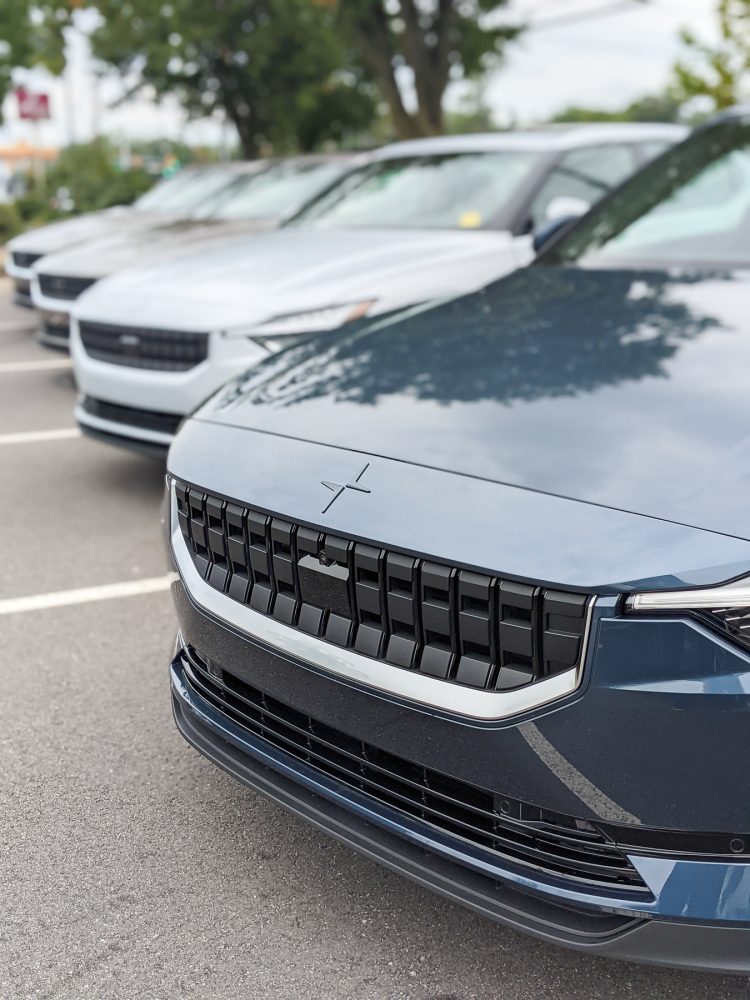
Polestar 2
I hadn’t heard of this car before we started test-driving electric vehicles for our family. It’s a relatively new brand that is owned partially by Volvo and partially by Volvo’s Chinese parent company. It’s probably more of a sporty car that isn’t designed specifically for families, but it was fun to check it out.
Pros
- trunk had functionality to lift up a supportive mini wall with an elastic strap around it to hold things like groceries and ensure they don’t move around while driving – this could be really useful
- fun and fast car that was rather tempting
- gorgeous colors!! so much nicer than other cars
- glass roof
- car felt really solid
- good camera technology – included the bird’s eye view which I really like
Cons
- very small interior; barely enough leg room in the backseat for kids and probably not enough for an adult to fit comfortably
- tiny frunk that couldn’t hold much more than a few books
- trunk was barely big enough for hockey equipment though it had an opening to put the seat down and put a hockey stick through the middle of the back seat
- don’t love that it’s owned by a Chinese company (I’d much prefer to support an American company)
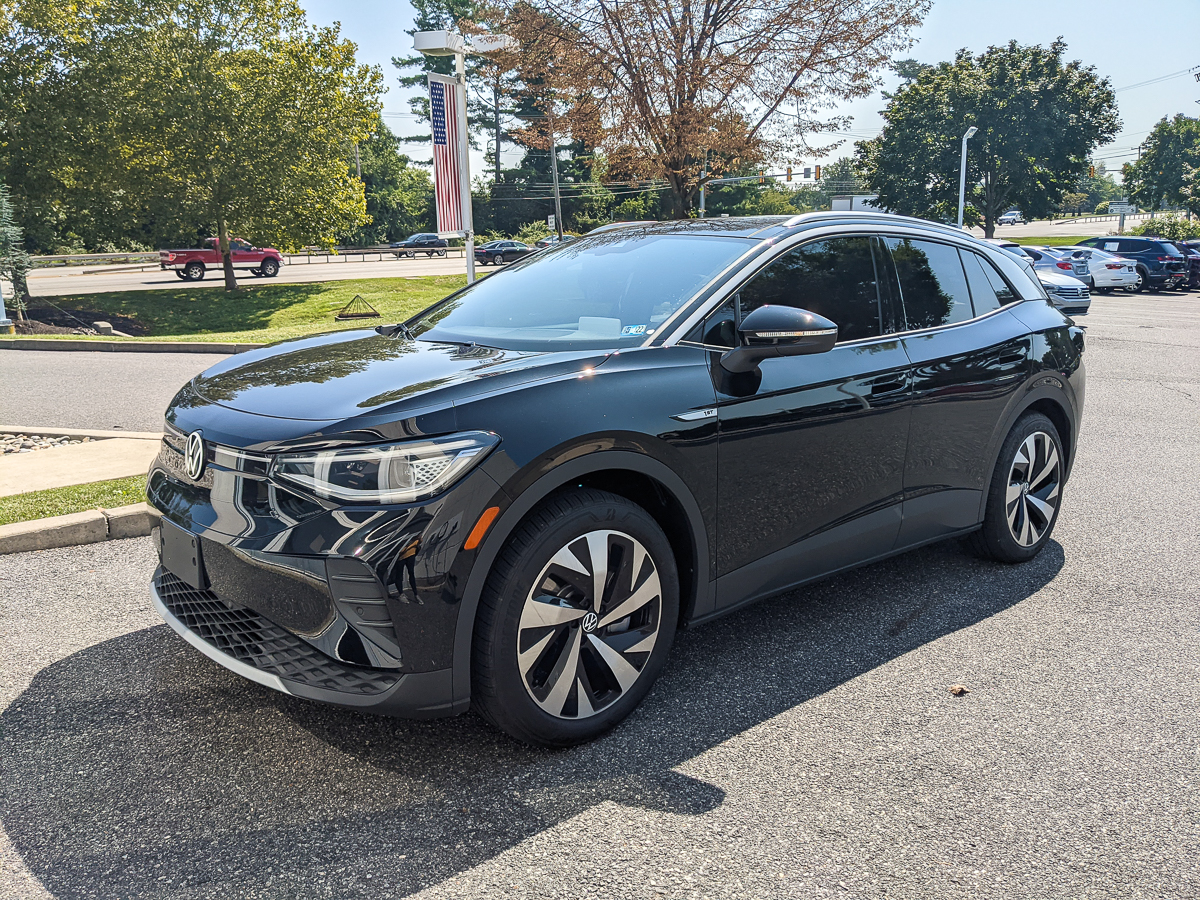
Volkswagen ID.4
This car is definitely a quintessential, American family car. It’s a good-sized crossover SUV car that feels classic and functional for all the kid things. They redesigned the car nicely to maximize interior space with an electric platform. If you’re looking for electric cars for families, this should definitely be on your shortlist. But be forewarned that, at least as of now, it has an incredibly long lead time.
Pros
- best interior space
- trunk was big enough for hockey equipment with a middle opening in the back seat for a hockey stick if it didn’t fit in the back trunk
- glass roof
- most comfortable, the most leg room in the back seat and the most head room for my husband who is tall; just felt the most practical
- drove nicely
Cons
- really long lead time, at least to get the dual motor option
- least fancy technology, but they do use big screens instead of buttons and knobs like more traditional cars have used
- least impressive camera technology; no bird’s eye view camera which I think can be really helpful (and it’s available on most cars) – I’m quite surprised it’s not included on this car
- Volkswagen doesn’t have the best ethics record; they had a major emissions scandal a few years back that has cost the company over $20 billion and also got in trouble for colluding with BMW regarding emissions technology
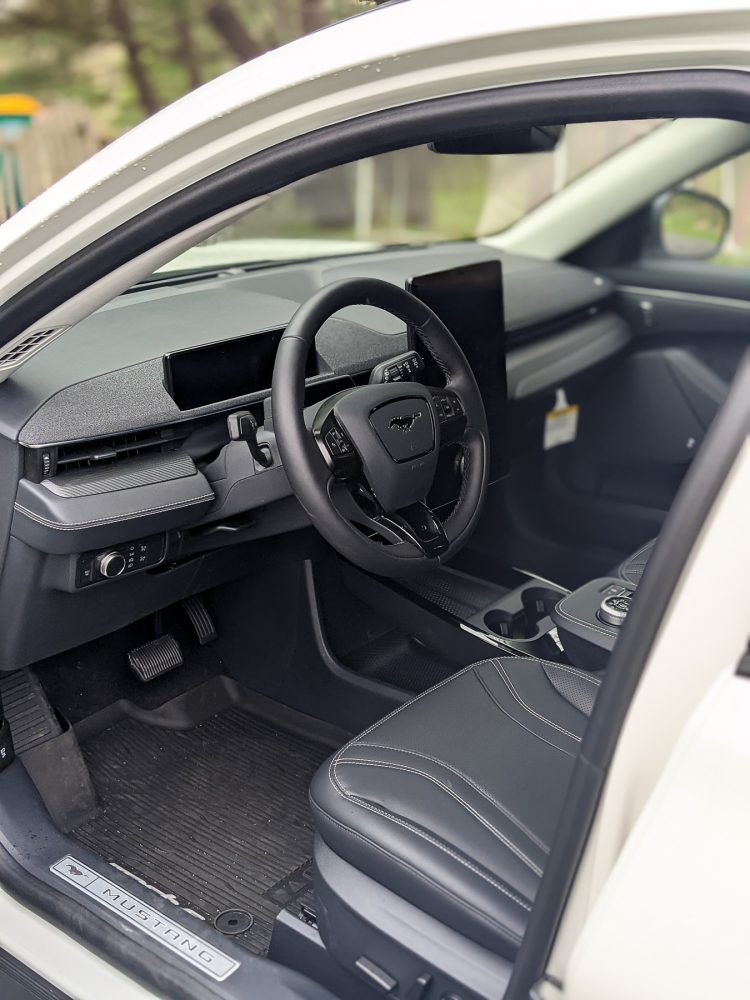
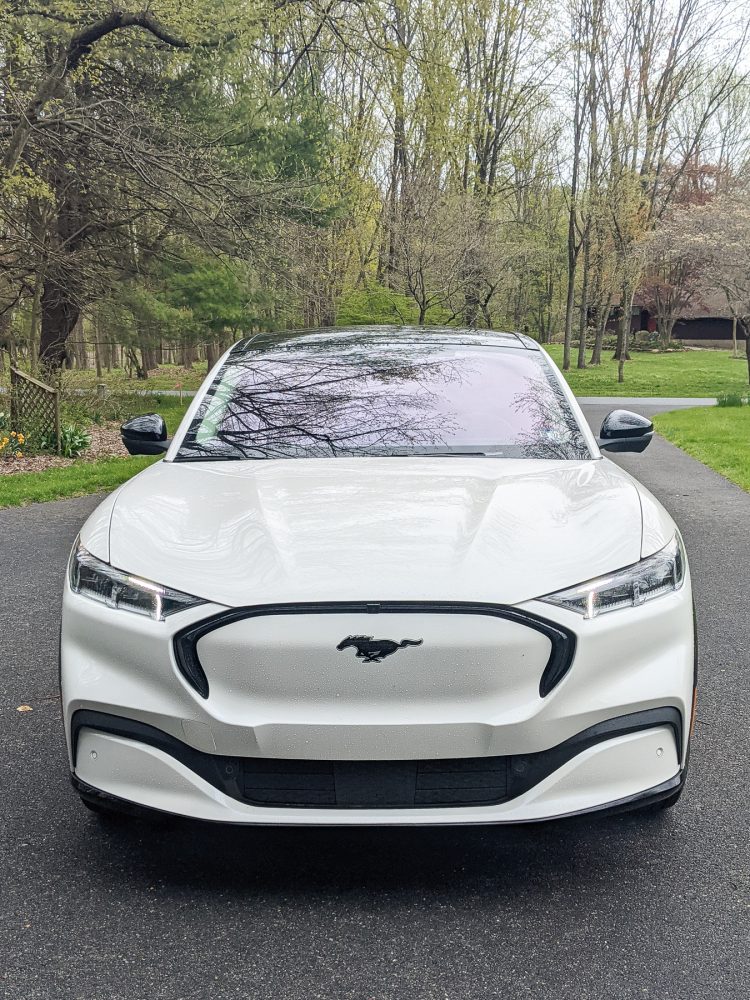
Mustang Mach-E
I really wanted to like this car. It was the first electric vehicle we drove, and Ford did a great job with the design. The Mach-E is a sharp-looking car with a great interior design and plenty of space for our family. I love that Ford is taking the lead on electric cars among the big American car brands.
However, I couldn’t ignore the feeling of how it drove. The car is really light, so it felt a bit like a go-kart to me. I think I would have liked that 15 years ago, but it just didn’t feel like the right fit for today. The light design, however, increases battery life. If you’re looking for a fun and exciting electric vehicle, I’d definitely give the Mach-E a shot.
Pros
- very light
- very quiet inside
- liked the functionality and interior set up; technology was really nice
- looks sharp; great design; feels luxurious for the brand
- would prefer to purchase an American car
Cons
- quick but felt like a go-kart; drive wasn’t as steady and solid as some of the other cars that we drove – this was ultimately the deal breaker for us on this one; I didn’t feel quite as comfortable driving it
Kia Niro EV
The Kia Niro EV was fine but not much more than that. It was the least expensive by a significant margin but also felt pretty boring. I’ve been impressed with the Kia Telluride and the Kia Stinger, so I think I expected something a bit more exciting.
While many of the other electric cars felt fancy and tech-forward on the inside with respect to controls and appearance, the Niro EV felt like a regular car that just had a battery instead of a combustion engine. It was lackluster, but admittedly could be a great choice if you’re more focused on price than aesthetics. Surprisingly, this was the second favorite option for both of my boys.
Pros
- fan of Kia in general; they’ve really stepped up lately with cars like the Telluride and the Stinger. We have several friends who’ve been really happy with them. I expect they will take market share over the next few years as more of their newer, nice cars come to market.
- Car is nice, very practical
- Least expensive
- Drove smoothly
- Quite spacious despite looking small; as much space as the ID.4
- Had cars on the lot so less uncertainty around long wait lists
Cons
- Most like a traditional car, just with a battery pack instead of an engine while other cars seemed to have done more extensive redesign overall.

When deciding to buy an electric car, there are some other considerations related to lifestyle that are also worth keeping in mind. Driving an electric car does require some adjustment relative to internal combustion engine vehicles.
Charging Our Electric Vehicle at Home
Of course, we will need to charge the car. Electric cars come with a simple Level 1 charger that you can plug into a regular outlet in your home, so technically, you don’t have to invest in any special equipment to charge your car.
Level 1 vs. Level 2 vs. Level 3 Chargers
However, Level 1 chargers take a really long time to charge your car (sometimes several days to get a full charge). That’s not hard to imagine when you think about charging your phone and your car with the same type of outlet. If you can charge your car at your office, for example, this might be a viable option. I do have a friend who does this and does not yet have a Level 2 or Level 3 charger.
Knowing our intent to go electric, we installed a generic Level 2 charger in our garage (or hired an electrician to do this because it’s certainly not in our skillset). We didn’t want to be limited with respect to a brand or type of charger, so we installed a 240-volt outlet that we can use with any electric vehicle. This Level 2 charger provides a full charge for the car in about 12 hours.
A Level 3 charger can power up a full charge in 15-60 minutes in a lot of cases, but we don’t expect to need that functionality at home. We can simply charge the car overnight in our garage as needed. According to the NRDC, charging overnight and using a slower charger also reduces the cost of electricity to charge the car, so a Level 2 charger will be plenty for us and hopefully limit the charging costs a bit.
Installing an Electric Car Charger At Home
The cost to install a charger at home for your electric vehicle will vary greatly. I think we paid about $750 for the labor and materials to install the 240-volt outlet (though it was part of a larger package of electrical work being done at our home).
Some brands offer specific chargers for their cars which may have benefits but are not necessary. Other brands may have limited-time offers to install chargers for free with the purchase or lease of the vehicle. Ask when you’re researching and test driving cars what options they have.
We own our home so we could easily install a charger at our discretion. If you rent a home or live in a shared residence, like a condominium building, you may need to ask your management company or owners’ association for details on what’s allowed and what options are available.
My sister and her husband live in a condo residence and park their EV in a garage under their building. They do not have the ability, at this point, to install a charger next to their parking spot. They don’t drive a lot of miles, so they only need to charge their car once a week or so. They charge it at local strip mall parking lots or gas stations with charging stations.
This may or may not work for you depending on where you live and how many charging stations are around. Hopefully, we will see continued investments from public and private funding to get more electric charging stations in public places.
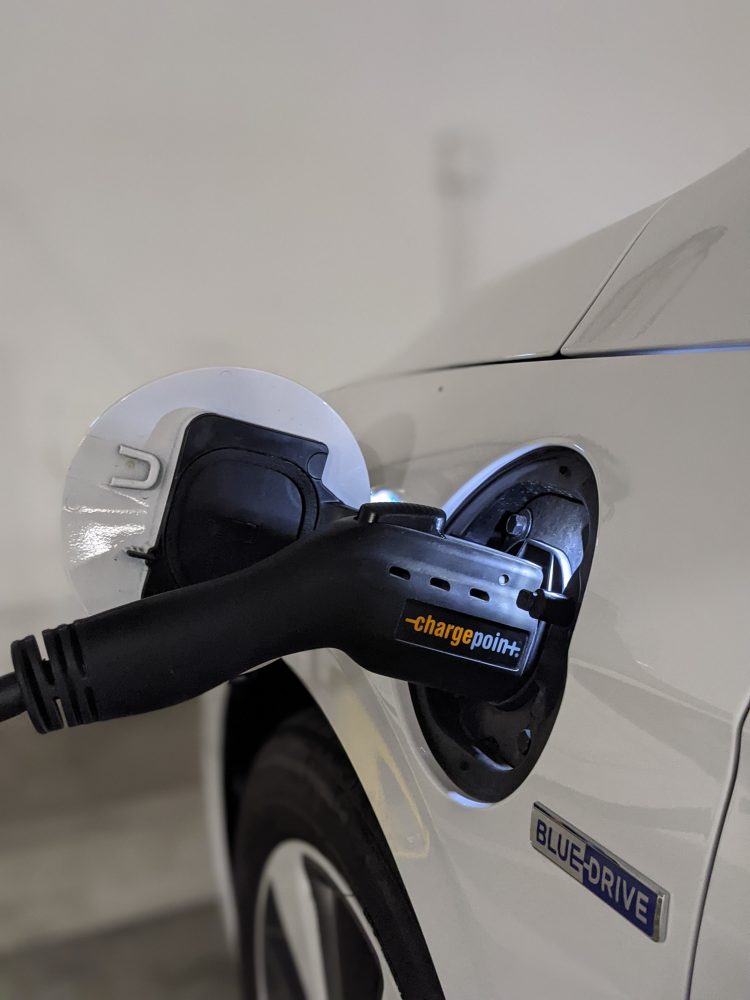
Charging Our Electric Car Away From Home
There is a growing network of charging stations we can use away from home. It’s worth noting, however, that certain generic charging stations work for all cars. Others, like Tesla charging stations, only work for Tesla cars. When deciding which electric vehicle to buy, keep in mind that your plug may only work with certain charging stations.
In places like California, there are lots of generic and Tesla charging stations in strip mall parking lots, gas stations, parking garages, and other public places. They have many generic charging stations that are paid for by municipal funding or part of private company EV charging station networks like ChargePoint. I have three sisters who live in California, and they don’t seem to have any accessibility issues (at least in their neighborhoods).
I live in Pennsylvania, and we have a far less robust network of charging stations in our region (at least as it appears to me). Furthermore, many of the charging stations I see are Tesla charging stations. While we will mostly charge our car at home, the abundance of Tesla-specific charging stations in our area relative to generic charging stations did factor into our final decision.
With new federal funding available for EV charging stations (in the United States), hopefully, we will see these popping up all over the place so they are as abundant as gas stations today.
Purchasing Our Electric Vehicle Online
As someone who despises the haggling and negotiation process of getting a new car, I loved that many of these cars are easily configured and purchased online now. In almost all cases, we could modify configurations, see price changes (for both buying and leasing) as a result of different configurations, and easily order our car online with the click of a few buttons. This gave us clarity and an easy way to compare prices and specs without having to drive around town and wait for someone at a dealer to work with us.
Are Electric Cars More Expensive Than Traditional Cars?
It depends. On a lot of factors.
According to Car and Driver research, the purchase price of an electric car is more expensive than its nearly identical internal combustion engine car, as of May 2020. As new cars come on the market and EV technology matures, this price discrepancy is sure to shrink.
Furthermore, many initial electric cars were luxury cars. There is an increasing number of less expensive electric alternatives giving those who are price-sensitive more options if they want to make the switch to an electric vehicle.
Also upon purchase, many EV owners may need to invest in some type of home charging system. As I mentioned above, it’s not necessary and some companies are also installing chargers with vehicle purchases for free, but it may increase an initial upfront payment when switching to an electric vehicle.
Despite the upfront investment, electric vehicles almost certainly have significantly lower ongoing maintenance costs. Electric cars don’t require oil changes and have far fewer standard maintenance requirements.
EVs don’t require gas (most obviously). Though savings on gasoline versus electricity depends a lot on where you live and how you charge, the electricity for a full charge is generally less expensive than a comparable amount of gasoline. EV owners will most likely see savings on the energy they purchase (i.e. electricity instead of gasoline) to run the vehicle.
Electric Car Tax Credits & Rebates (in the United States)
Note: I live in the United States, so this section applies to those who live in the US. I can barely navigate our own federal, state, and local tax codes, so I have no idea what publicly-funded benefits exist in other counties. It’s worth considering if there are benefits available where you live.
United States Federal Tax Credit
Tax credits can also greatly contribute to the overall price difference between the two types of cars. Currently, EV owners can receive up to $7,500 in US federal tax credits and may be eligible for more state and local credits depending on where they live.
Yet this isn’t so clear. Some car companies (like Tesla and General Motors) have used up all their federal tax credits. Because we purchased a Tesla, we aren’t eligible for this tax credit.
Furthermore, the tax credits will certainly change by 2022 when we take delivery of our new EV. As of today, it’s unclear what tax credits will be available and for whom. The $7,500 credit expires on December 31, 2021, but a current bill in Congress includes tax credits for up to $12,500 for certain types of cars and certain taxpayers. That’s a huge financial incentive to go electric and will certainly swing the financial comparison between EVs and gas-guzzling cars.
Because we can’t predict the future (and certainly can’t predict how the unruly United States Congress will act), we made our decision with the assumption that we would not receive a federal tax credit for our purchase. If we qualify, it’s a bonus. If not, it’s what we budgeted.
Other Local Tax Credits & Rebates
Where we live, we have several other tax credits and rebates for which we may qualify. Some are related to the car while others are related to the charging infrastructure. Our local utility company provides an introductory summary of what is available in our local area, and your utility or local government website may do the same as well.
In our case, there are up to $9,300 in tax credits and rebates available to those in our community (provided they meet specific criteria for each credit or rebate). These will change over time, but they provide significant financial benefits to the relative cost analysis.
So what electric car did we choose for our active suburban family of four?
Tesla Model 3. My nine-year-old son actually ordered it. I’m a bit of a contrarian and don’t generally like to follow the crowd when I have another option. I can thank my dad for that genetic tendency. So I didn’t really want to choose the Tesla. They’re popping up everywhere; it’s what all the cool kids are doing these days. I wanted to be different.
But in the end, it made the most sense. They have the longest history of managing the technology (while several other car companies just getting into the electric car market are experiencing hiccups).
Tesla’s cars are sturdy, quiet, reliable, and efficient. Around us, they have the best network of charging stations. In short, there’s a reason so many people are driving them (and it’s not just for vanity points). In the current market, if it’s in your budget, I think the Tesla Model 3 makes a whole lot of sense.
It didn’t hurt that my boys were absolutely dying to get a Tesla, so I won some cool Mom points for letting them ultimately get what they wanted (but that was certainly not the driving factor).
If You Like This Post, You Might Also Like
Is An Electric Car Right For You?
6 Reasons We Chose Not To Lease An Electric Car
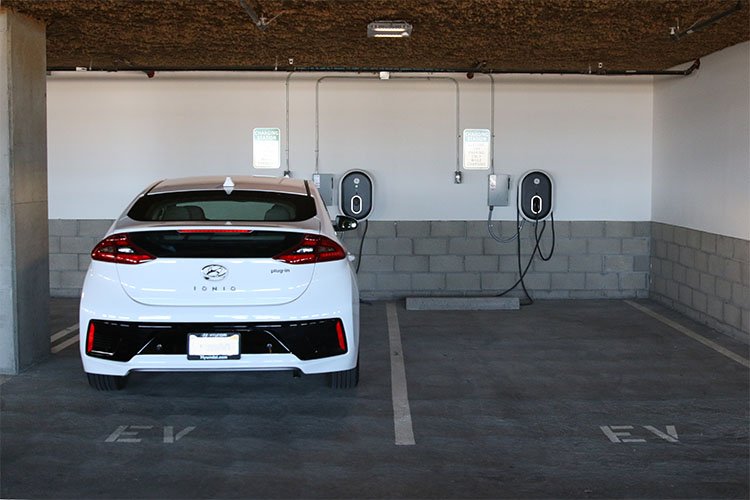

Jen Panaro
Jen Panaro, founder and editor-in-chief of Honestly Modern, is a self-proclaimed composting nerd and advocate for sustainable living for modern families. To find her latest work, subscribe to her newsletter, Stepping Stones.
In her spare time, she’s a serial library book borrower, a messy gardener, and a mom of two boys who spends a lot of time in hockey rinks and on baseball fields.
You can find more of her work at Raising Global Kidizens, an online space to help parents and caregivers raise the next generation of responsible global citizens.







